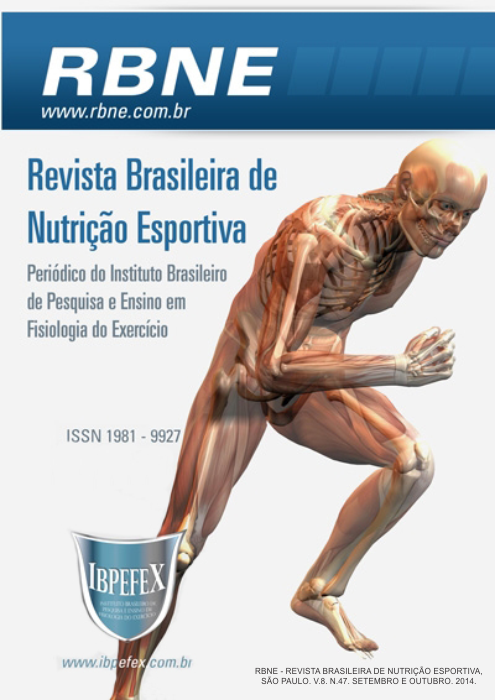The creatine peak administration do not alter glucose homeostasis and decreases food intake in rats
Abstract
O presente estudo verificou a homeostase glicêmica e as ingestões hídricas e alimentar de ratos alimentados ou não com dieta acrescida de creatina. Dez ratos Wistar machos foram submetidos ao ensaio tipo cross-overe alimentados com dieta acrescida de creatina em fasede saturação celular (pico) (AIN-93M + 13% de creatina) ou dieta padrão (AIN-93M). Peso corporal e ingestões hídrica e alimentar foram registrados cinco dias/semana; ao final de cada período de administração da creatina (10 dias) os animais realizaram o GTT e o ITT. A creatina em fase pico não alterou a homeostase glicêmica dos animais, aumentou a ingestão hídrica e diminuiu a ingestão alimentar. Estudos futuros são requeridos para verificar até que ponto a administração de creatina, em diferentes formas, altera de forma significativa o balanço hídrico, a osmolaridade intra e extracelular e, até mesmo, os mecanismos de sede, fome e saciedade, os quais são modulados pelo hipotálamo.
References
-Alsever, R. N.; Gerog, R. H.; Sussaman, K. E. Stimulation of insulin secretion by guanidine acetic acid and other guanidine derivatives. Endocrinology, Stanford. Vol. 86. Núm.. 2. p. 332-336.1970.
-Araújo, M. B.; Mello, M. A. R. Exercício, estresse oxidativo e suplementação com creatina. Revista Brasileira de Nutrição Esportiva. São Paulo. Vol. 3. Núm. 15. p. 264-272. 2009.
-Berneis, K.; e colaboradores. Effects of hyper and hypoosmolality on whole body protein and glucose kinetics in humans. The American Journal of Physiology: Endocrinology and Metabolism. Bethesda. Vol. 276. Núm.1. p. E188-E195. 1999.
-Bonora, E.; e colaboradores. Estimates of in vivo insulin action in man: comparison of insulin tolerance tests with euglycemic and hyperglycemic glucose clamp studies. The Journal of Clinical Endocrinology & Metabolism. Stanford. Vol. 68. Núm. 2. p. 374-378.1989.
-Brach, J. D. Effect of creatine supplementation on body composition and performance: ameta-analysis. International Journal of Sport Nutrition and Exercise Metabolism. Champaign. Vol. 13. Núm. 2. p. 198-226. 2003.
-Costallat, B. L.; e colaboradores. Resistência à insulina com a suplementação de creatina em animais de experimentação. Revista Brasileira de Medicina do Esporte. Vol. 13. Núm. 1. p. 22-26. 2007.
-Deldicque, L.; e colaboradores. Increased IGF mRNA in human skeletal muscle after creatine supplementation. Medicine and Science in Sports and Exercise. Hagerstown. Vol. 37. Núm. 5. p. 731-736. 2005.
-Deminice, R.; e colaboradores. Effects of creatine supplementation on homocysteine levels and lipid peroxidation in rats. British Journal of Nutrition. Cambridge. Vol. 102. Núm. 1. p. 110-116. 2009.
-Gualano, B.; e colaboradores. Effects of creatine supplementation on glucose tolerance and insulin sensitivity in sedentary healthy males undergoing aerobic training. Amino Acids, Wien. Vol. 34. Núm. 2. p. 245-250. 2008.
-Harris, R.C.; Söderlund, K.; Hultman, E.Elevation of creatine in resting and exercised muscle of normal subjects by creatine supplementation. Clinical Science. London. Vol. 83. Núm. 3. p. 367-374. 1992.
-Hultman, E.; e colaboradores. Muscle creatine loading in man.Journal ofApplied Physiology.Bethesda. Vol. 81. Núm. 1. p. 232-237. 1996.
-Lawller, J.M.; e colaboradores. Direct Antioxidant Properties of Creatine. Biochemical and Biophysical Research Communications, Salt Lake City. Vol. 290. Núm. 1. p. 47-52. 2002.
-Mathews,J.N.; e colaboradores. Analysis of serial measurements in medical research. British Medical Journal. London. Vol. 300. Núm. 6719. p. 230-235. 1990.
-Mendes, R.R.; Tirapegui, J. Considerações sobre o exercício físico, creatina e nutrição. Revista Brasileira de Ciências Farmacêuticas. Vol. 35. Núm. 2. p. 196-209. 1999.
-Newman, J.E.; e colaboradores. Effect of creatine ingestion on glucose tolerance and insulin sensitivity in men. Medicine and Science in Sports and Exercise.Hagerstown. Vol. 35. Núm. 1. p. 69-74. 2003.
-Nissen, S.L.; Sharp, R.L. Effect of dietary supplements on lean mass and strength gains with resistance exercise: a meta-analisys. Journal of Applied Physiology. Bethesda. Vol. 94. Núm. 2. p. 651-659. 2003.
-Op‘Teijnde, B.; e colaboradores. Effect of oral creatine supplementation on human muscle GLUT4 protein content after immobilization.Diabetes. Alexandria. Vol. 50. Núm. 1. p. 18-23. 2001.
-Reeves, P.G.; Nielsen, F.H.; Fahey, G.C.JR. AIN-93 purified diets for laboratory rodents: final report of the American Institute of Nutrition ad hoc writing committee on the reformulation of the AIN-76A rodentdiet. The Journal of Nutrition. Bethesda. Vol. 123. Núm. 11. p. 1939-1951.1993.
-Rooney, K.; e colaboradores. Creatine supplementation alters insulin secretion and glucose homeostasis in vivo. Metabolism: clinical and experimental. Baltimore. Vol. 51. Núm. 4. p. 518-522. 2002.
-Vandenberghe, K.; e colaboradores. Long-term creatine intake is beneficial to muscle performance during resistance training. Journal of Applied Physiology. Bethesda. Vol. 83. Núm. 6. p. 2055-2063. 1997.
-Volek, J. S.; e colaboradores. Performanceand musclefiberadaptationsto creatinesupplementationand heavyresistance training.Medicine and Science in Sports and Exercise.Hagerstown. Vol. 31. Núm. 8. p. 1147-1156. 1999.
-Walker, J. B. Creatine: Biosynthesis, Regulation and Function. Advances Enzymology and Related Áreas of Molecular Biology. Baldwin. Vol. 50. p. 177-242.1979.
-Wyss, M.; Schulze, A. Health implications of creatine: can oral creatine supplementation protect against neurological and atherosclerotic disease? Neuroscience. Washington. Vol. 112. Núm. 2. p. 243-260. 2002.
Authors who publish in this journal agree to the following terms:
- Authors retain the copyright and grant the journal the right of first publication, with work simultaneously licensed under the Creative Commons Attribution License BY-NC which allows the sharing of the work with acknowledgment of the authorship of the work and initial publication in this journal.
- Authors are authorized to enter into additional contracts separately for non-exclusive distribution of the version of the work published in this journal (eg, publishing in institutional repository or book chapter), with acknowledgment of authorship and initial publication in this journal.
- Authors are allowed and encouraged to post and distribute their work online (eg, in institutional repositories or on their personal page) at any point before or during the editorial process, as this can bring about productive change as well as increase impact and impact. citation of published work (See The Effect of Free Access).






